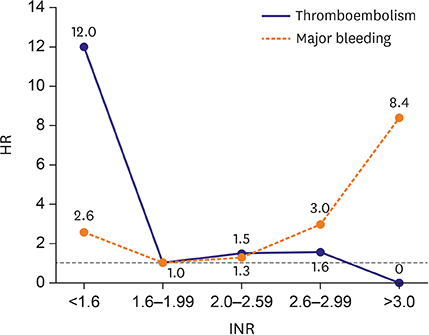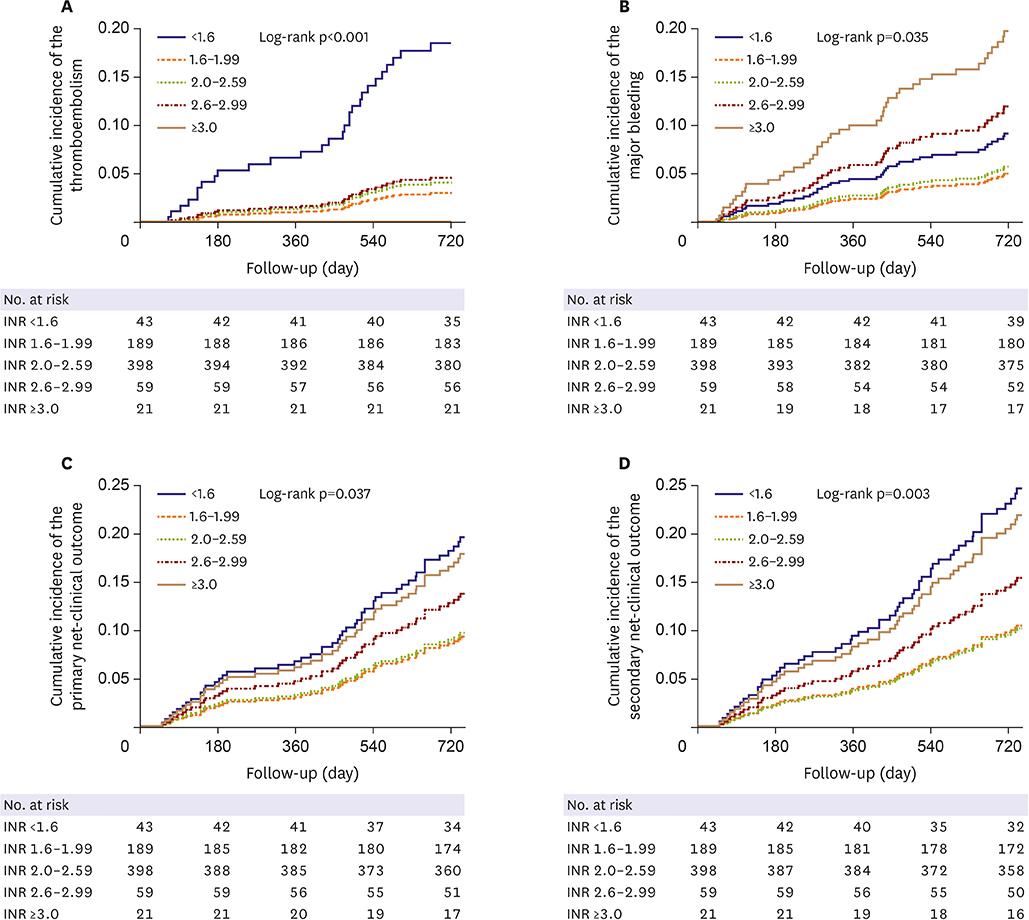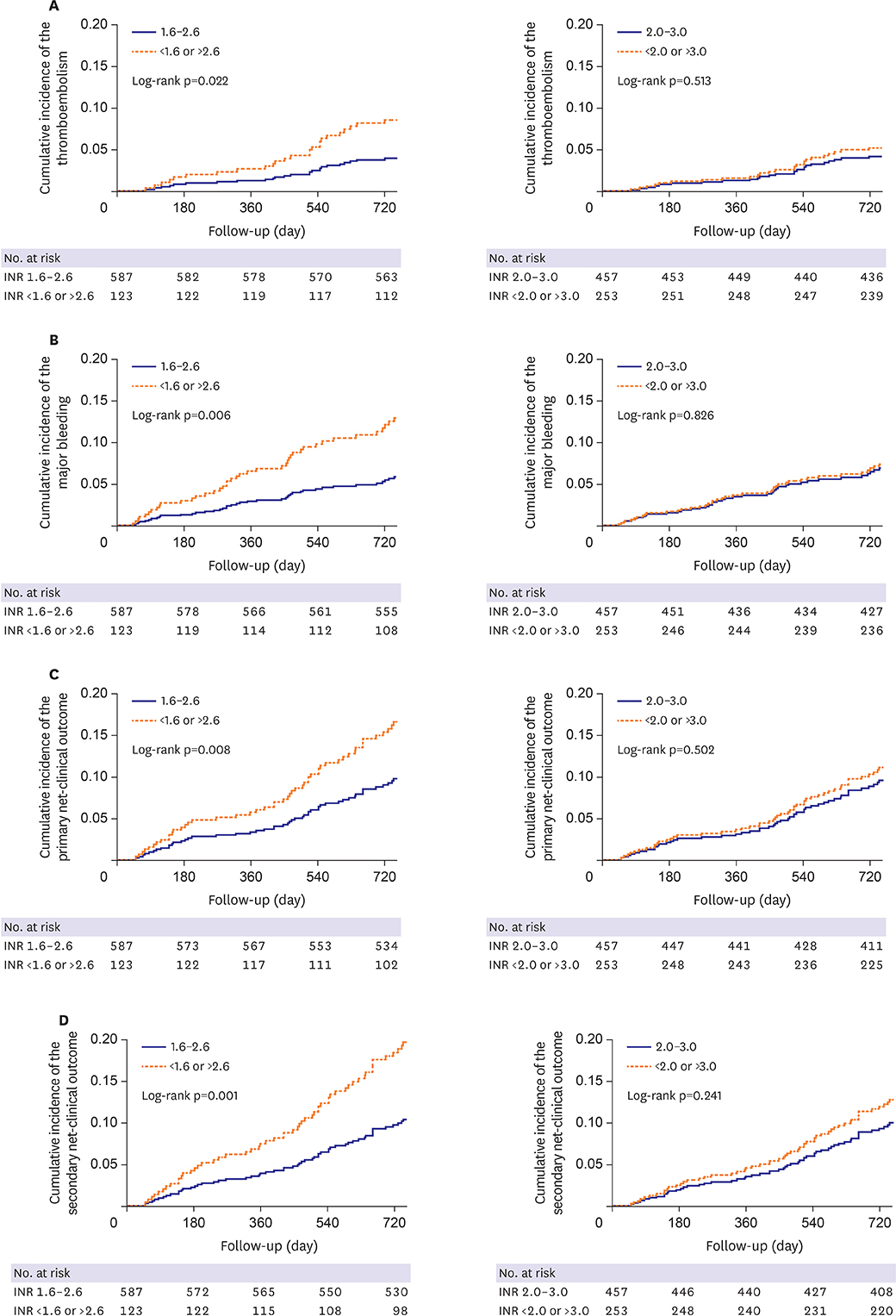Korean Circ J.
2020 Feb;50(2):163-175. 10.4070/kcj.2019.0099.
Impact of Anticoagulation Intensity in Korean Patients with Atrial Fibrillation: Is It Different from Western Population?
- Affiliations
-
- 1Department of Cardiovascular Medicine, The Heart Center of Chonnam National University Hospital, Gwangju, Korea. skawn77@gmail.com
- KMID: 2468043
- DOI: http://doi.org/10.4070/kcj.2019.0099
Abstract
- BACKGROUND AND OBJECTIVES
Although anticoagulation with warfarin is recommended as an international normalized ratio (INR) of prothrombin time between 2.0 and 3.0 and mean time in the therapeutic range (TTR) ≥70%, little has been proven that universal criteria might be suitable in Korean atrial fibrillation (AF) patients.
METHODS
We analyzed 710 patients with non-valvular AF who took warfarin. INR value and clinical outcomes were assessed during 2-year follow-up. Intensity of anticoagulation was assessed as mean INR value and TTR according to target INR range. Primary net-clinical outcome was defined as the composite of new-onset stroke and major bleeding. Secondary net-clinical outcome was defined as the composite of new-onset stroke, major bleeding and death.
RESULTS
Thromboembolism was significantly decreased when mean INR was over 1.6. Major bleeding was significantly decreased when TTR was over 70% and mean INR was less than 2.6. Mean INR 1.6-2.6 significantly reduced thromboembolism (adjusted hazard ratio [HR], 0.40; 95% confidence interval [CI], 0.19-0.85), major bleeding (HR, 0.43; 95% CI, 0.23-0.81), primary (HR, 0.50; 95% CI, 0.29-0.84) and secondary (HR, 0.45; 95% CI, 0.28-0.74) net-clinical outcomes, whereas mean INR 2.0-3.0 did not. Simultaneous satisfaction of mean INR 1.6-2.6 and TTR ≥70% was associated with significant risk reduction of major bleeding, primary and secondary net-clinical outcomes.
CONCLUSIONS
Mean INR 1.6-2.6 was better than mean INR 2.0-3.0 for the prevention of thromboembolism and major bleeding. However, INR 1.6-2.6 and TTR ≥70% had similar clinical outcomes to INR 2.0-3.0 and TTR ≥70% in Korean patients with non-valvular AF.
Keyword
MeSH Terms
Figure
Cited by 2 articles
-
Is Lighter Intensity of Warfarin Therapy Enough for Korean Patients with Non-Valvular Atrial Fibrillation?
So-Ryoung Lee
Korean Circ J. 2020;50(2):176-178. doi: 10.4070/kcj.2019.0350.How to Overcome Social Inequalities of Oral Anticoagulation Usage in Korea?
Ki Hong Lee
Korean Circ J. 2020;50(3):278-280. doi: 10.4070/kcj.2020.0007.
Reference
-
1. Kirchhof P, Benussi S, Kotecha D, et al. 2016 ESC guidelines for the management of atrial fibrillation developed in collaboration with EACTS. Eur Heart J. 2016; 37:2893–2962.2. January CT, Wann LS, Alpert JS, et al. 2014 AHA/ACC/HRS guideline for the management of patients with atrial fibrillation: a report of the American College of Cardiology/American Heart Association Task Force on practice guidelines and the Heart Rhythm Society. Circulation. 2014; 130:e199–e267.3. JCS Joint Working Group. Guidelines for pharmacotherapy of atrial fibrillation (JCS 2013). Circ J. 2014; 78:1997–2021.4. You JH, Chan FW, Wong RS, Cheng G. Is INR between 2.0 and 3.0 the optimal level for Chinese patients on warfarin therapy for moderate-intensity anticoagulation? Br J Clin Pharmacol. 2005; 59:582–587.
Article5. Chenhsu RY, Chiang SC, Chou MH, Lin MF. Long-term treatment with warfarin in Chinese population. Ann Pharmacother. 2000; 34:1395–1401.
Article6. Poller L, Taberner DA. Dosage and control of oral anticoagulants: an international collaborative survey. Br J Haematol. 1982; 51:479–485.
Article7. Gan GG, Teh A, Goh KY, Chong HT, Pang KW. Racial background is a determinant factor in the maintenance dosage of warfarin. Int J Hematol. 2003; 78:84–86.
Article8. Capodanno D, Angiolillo DJ. Impact of race and gender on antithrombotic therapy. Thromb Haemost. 2010; 104:471–484.
Article9. Lip GY, Wang KL, Chiang CE. Non-vitamin K antagonist oral anticoagulants (NOACs) for stroke prevention in Asian patients with atrial fibrillation: time for a reappraisal. Int J Cardiol. 2015; 180:246–254.
Article10. Rosendaal FR, Cannegieter SC, van der Meer FJ, Briët E. A method to determine the optimal intensity of oral anticoagulant therapy. Thromb Haemost. 1993; 69:236–239.
Article11. Cabral KP, Ansell J, Hylek EM. Future directions of stroke prevention in atrial fibrillation: the potential impact of novel anticoagulants and stroke risk stratification. J Thromb Haemost. 2011; 9:441–449.
Article12. Petersen P, Godtfredsen J, Boysen G, Andersen ED, Andersen B. Placebo-controlled, randomised trial of warfarin and aspirin for prevention of thromboembolic complications in chronic atrial fibrillation. The Copenhagen AFASAK study. Lancet. 1989; 1:175–179.13. Boston Area Anticoagulation Trial for Atrial Fibrillation Investigators. Singer DE, Hughes RA, et al. The effect of low-dose warfarin on the risk of stroke in patients with nonrheumatic atrial fibrillation. N Engl J Med. 1990; 323:1505–1511.
Article14. Stroke prevention in atrial fibrillation study. Final results. Circulation. 1991; 84:527–539.15. Connolly SJ, Laupacis A, Gent M, Roberts RS, Cairns JA, Joyner C. Canadian Atrial Fibrillation Anticoagulation (CAFA) study. J Am Coll Cardiol. 1991; 18:349–355.16. Ezekowitz MD, Bridgers SL, James KE, et al. Warfarin in the prevention of stroke associated with nonrheumatic atrial fibrillation. N Engl J Med. 1992; 327:1406–1412.
Article17. Yamaguchi T. Japanese Nonvalvular Atrial Fibrillation-Embolism Secondary Prevention Cooperative Study Group. Optimal intensity of warfarin therapy for secondary prevention of stroke in patients with nonvalvular atrial fibrillation: a multicenter, prospective, randomized trial. Stroke. 2000; 31:817–821.18. Yasaka M, Minematsu K, Yamaguchi T. Optimal intensity of international normalized ratio in warfarin therapy for secondary prevention of stroke in patients with non-valvular atrial fibrillation. Intern Med. 2001; 40:1183–1188.
Article19. Atarashi H, Inoue H, Okumura K, Yamashita T, Origasa H. J-RHYTHM Registry Investigators. Investigation of optimal anticoagulation strategy for stroke prevention in Japanese patients with atrial fibrillation--the J-RHYTHM Registry study design. J Cardiol. 2011; 57:95–99.
Article20. European Atrial Fibrillation Trial Study Group. Optimal oral anticoagulant therapy in patients with nonrheumatic atrial fibrillation and recent cerebral ischemia. N Engl J Med. 1995; 333:5–10.21. Adjusted-dose warfarin versus low-intensity, fixed-dose warfarin plus aspirin for high-risk patients with atrial fibrillation: stroke prevention in atrial fibrillation III randomised clinical trial. Lancet. 1996; 348:633–638.22. Marín F, González-Conejero R, Capranzano P, Bass TA, Roldán V, Angiolillo DJ. Pharmacogenetics in cardiovascular antithrombotic therapy. J Am Coll Cardiol. 2009; 54:1041–1057.
Article23. Lee JY, Kim TH, Yang PS, et al. Korean atrial fibrillation network genome-wide association study for early-onset atrial fibrillation identifies novel susceptibility loci. Eur Heart J. 2017; 38:2586–2594.
Article24. Suzuki S, Yamashita T, Kato T, et al. Incidence of major bleeding complication of warfarin therapy in Japanese patients with atrial fibrillation. Circ J. 2007; 71:761–765.
Article25. Yamashita T, Inoue H, Okumura K, Atarashi H, Origasa H. J-RHYTHM Registry Investigators. Warfarin anticoagulation intensity in Japanese nonvalvular atrial fibrillation patients: a J-RHYTHM Registry analysis. J Cardiol. 2015; 65:175–177.
Article26. Inoue H, Okumura K, Atarashi H, et al. Target international normalized ratio values for preventing thromboembolic and hemorrhagic events in Japanese patients with non-valvular atrial fibrillation: results of the J-RHYTHM Registry. Circ J. 2013; 77:2264–2270.27. Kodani E, Atarashi H, Inoue H, Okumura K, Yamashita T. J-RHYTHM Registry Investigators. Target intensity of anticoagulation with warfarin in Japanese patients with valvular atrial fibrillation – subanalysis of the J-RHYTHM Registry. Circ J. 2015; 79:325–330.
- Full Text Links
- Actions
-
Cited
- CITED
-
- Close
- Share
- Similar articles
-
- How and When to Screen for Atrial Fibrillation after Stroke: Insights from Insertable Cardiac Monitoring Devices
- The Mechanism of and Preventive Therapy for Stroke in Patients with Atrial Fibrillation
- Clinical Characteristics and Management in Elderly Patients with Atrial Fibrillation
- Stroke Prevention in Atrial Fibrillation
- Cardioembolic Stroke in Atrial Fibrillation-Rationale for Preventive Closure of the Left Atrial Appendage




